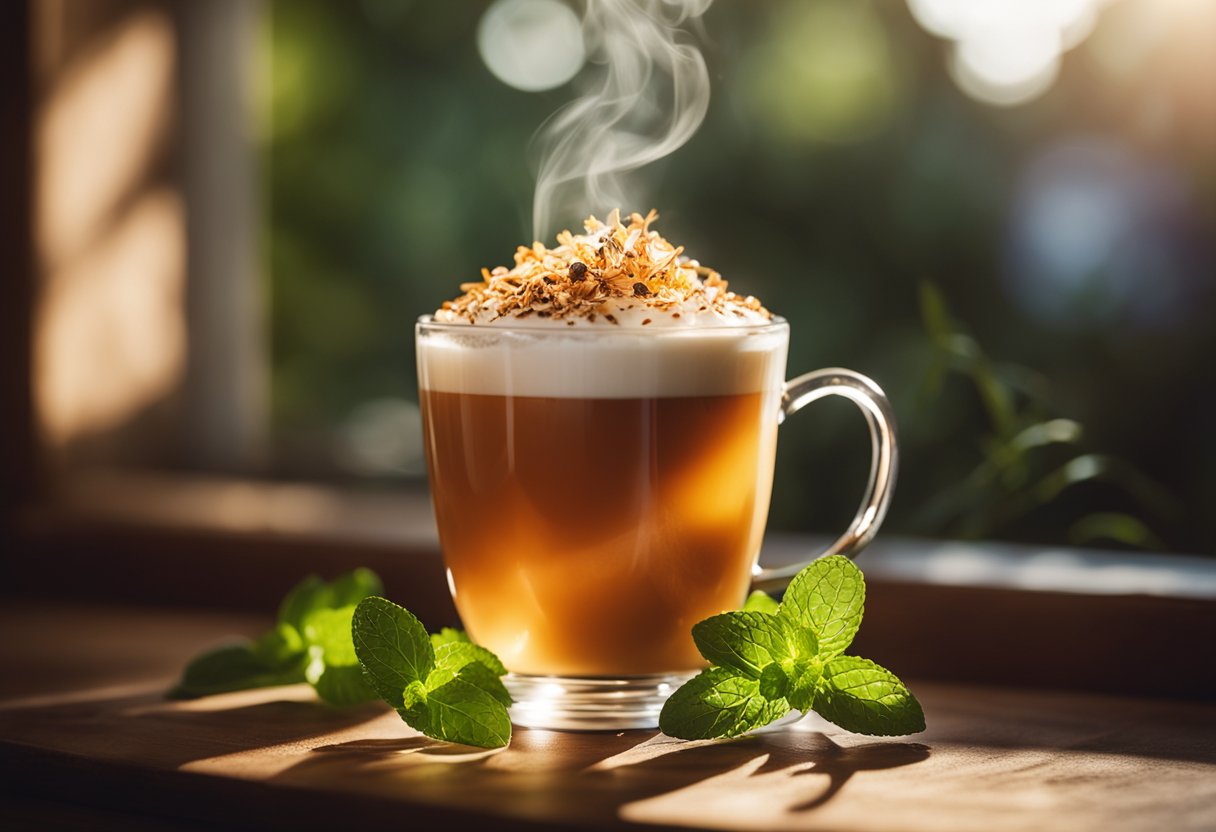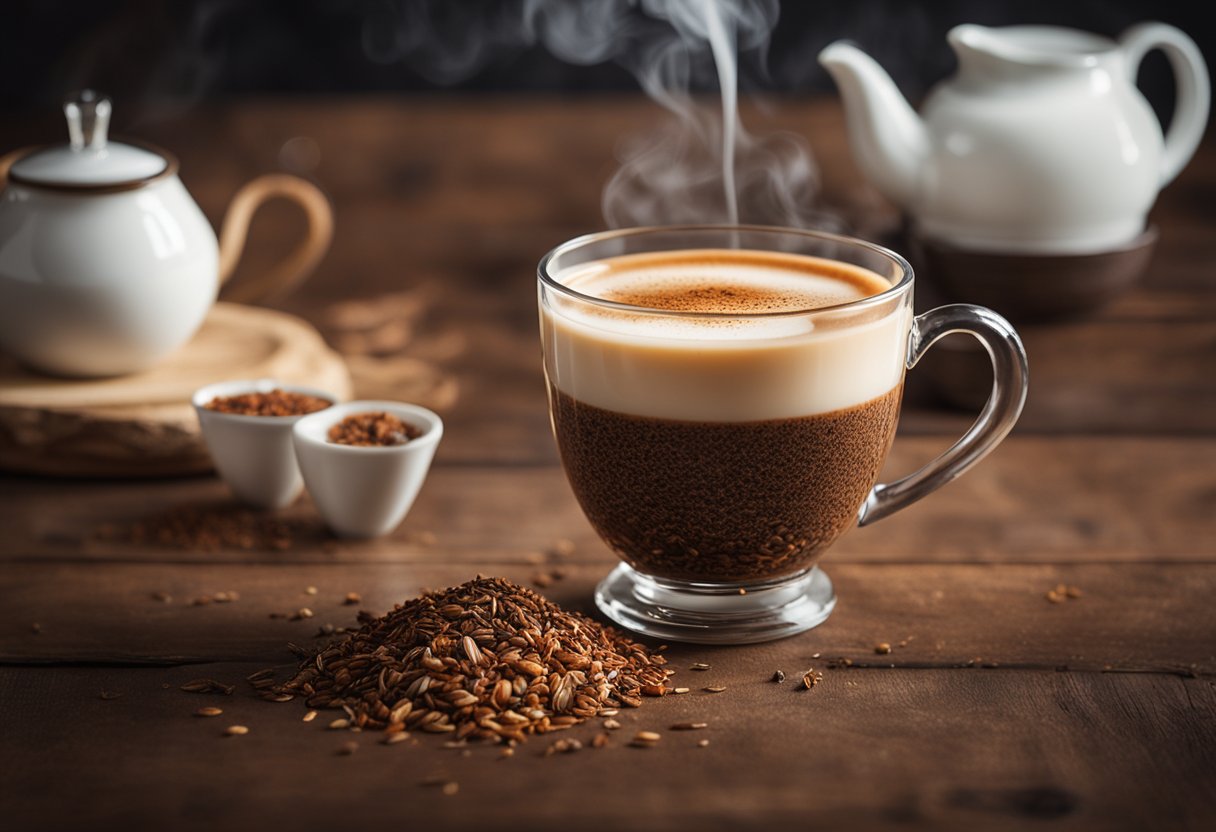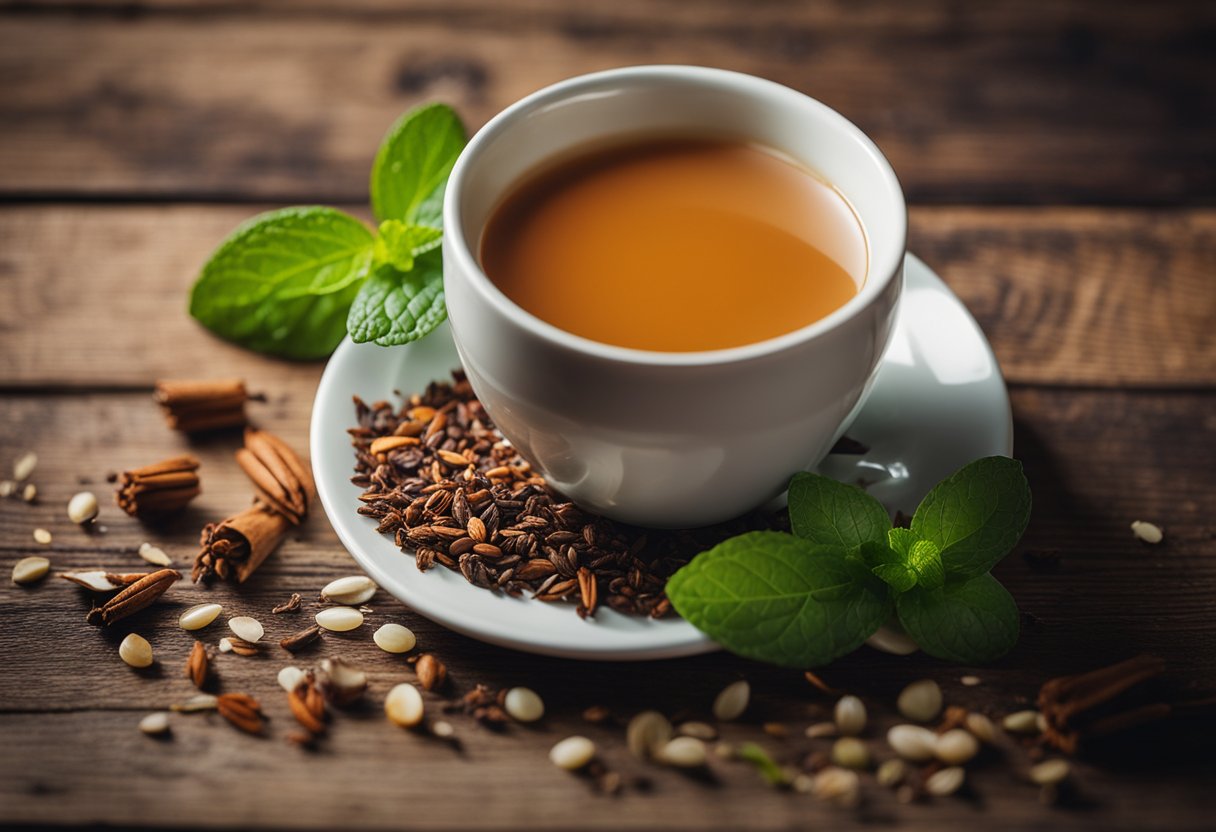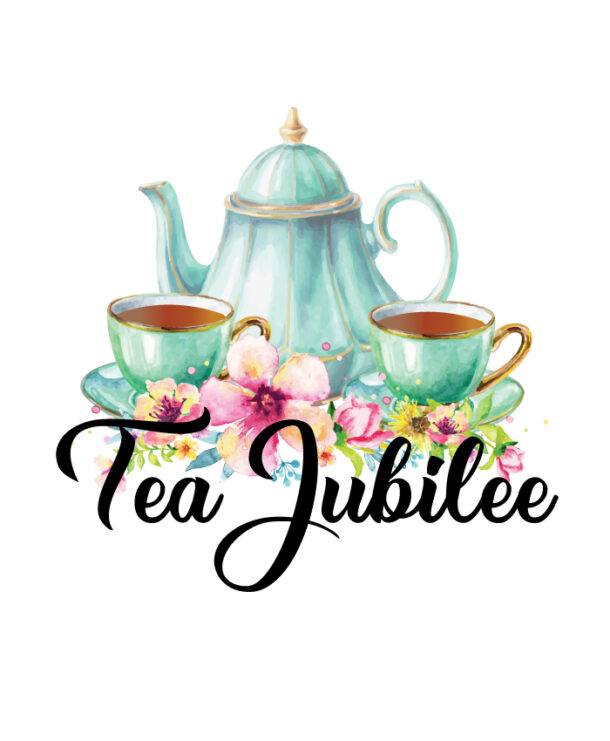==================
A Caveat and Affiliates
First off, a little caveat: within my articles you will find affiliate links, meaning if you buy them, I get a small commission. Your cost is not affected. In addition, I am an Amazon Associate and I earn from qualifying purchases on Amazon.
And yes, if I say that I recommend a product here, it means I truly believe it is a good product. I refuse to recommend any product that I have not researched and believe to be a good value.
Even better, I provide you with a very clear picture of the product, it’s use, and the probable value.
Earning your trust is important to me. I run this website myself and the commissions and donations help support the site.
Sound reasonable and fair enough? Let’s continue to the article.
==================
Contents
Rooibos Latte: Crafting the Perfect Cup of South African Red Espresso
Rooibos latte is a warm, comforting beverage blending rooibos tea’s rich, earthy flavors with steamed milk’s creamy texture. Originating from the South African red bush plant, rooibos, also known as red tea, is naturally caffeine-free and boasts a high level of antioxidants. Its rise in popularity among tea aficionados and coffee drinkers alike stems from its health benefits and versatility.
For those seeking an alternative to coffee-based lattes, rooibos offers a smooth, slightly sweet base for a variety of latte preparations. Steaming the milk enhances the tea’s naturally sweet profile and creates a frothy layer that is visually appealing and pleasant on the palate. When compared to traditional espresso lattes, a rooibos latte presents a gentle, soothing experience ideal for any time of the day, especially in the evening when caffeine might be undesirable.
We appreciate the cafe culture’s embrace of rooibos lattes as evidence of the widespread appeal of rooibos tea. The drink can easily be customized with different syrups, spices, and types of milk to cater to individual tastes, reflecting the creativity and personalization that has become a hallmark of modern café offerings. The beverage delivers an indulgent taste sensation and contributes to a healthy lifestyle, making it a win-win choice for the conscious consumer.
History of Rooibos Latte

Rooibos tea hails from the Cederberg region of South Africa, where it has been consumed for centuries. The indigenous Khoisan people were the first to harvest and use the red bush plant for herbal remedies.
Rooibos itself means “red bush” in Afrikaans, and the tea has a distinctive reddish color and sweet, nutty flavor. It gained popularity as an alternative to black tea during World War II when traditional tea supplies were disrupted.
The creation of the Rooibos latte is a more recent phenomenon, reflecting a global trend towards health-focused variations of classic drinks. Our investigation suggests its popularization occurred in the early 21st century, alongside the rise of coffee shop culture and the demand for caffeine-free alternatives. The Rooibos latte is a combination of steamed milk and concentrated Rooibos tea, often enhanced with a sweetener or spices like cinnamon.
Here’s a brief timeline showcasing the key developments:
| Year | Development |
|---|---|
| Pre-20th century | Indigenous use of the Rooibos plant for herbal remedies. |
| Circa 1900s | Commercial cultivation begins. |
| World War II | Rooibos gained popularity as an alternative to black tea. |
| The early 2000s | Rooibos lattes emerge in coffee shops. |
The beverage is typically prepared in coffee shops with steamed milk, creating a warm, frothy concoction. Its unique taste and health benefits, such as being caffeine-free and packed with antioxidants, have cemented its place in the array of modern specialty teas.
What is Rooibos?

We’re discussing a unique herbal tea known for its rich color and flavor. Rooibos, also called red bush tea, is a plant native to South Africa.
Origin and Cultivation
Rooibos (Aspalathus linearis) is indigenous to the Cederberg region of South Africa. It thrives in a Mediterranean climate and is not found naturally anywhere else on Earth. The growing and harvesting process of Rooibos is a testament to sustainable agriculture. We see it cultivated in a way that aligns with its natural growth cycle, often with minimal impact on the environment.
Farmers plant the seeds in February and March, and the crop is ready for harvesting about 18 months later. Once the leaves are plucked, they undergo fermentation, which enhances their flavor and gives them their distinctive red hue. Rooibos is often organically grown, ensuring that we can enjoy it in the most natural form possible.
Health Benefits
Rooibos tea stands out for its potential health benefits. The leaves are naturally caffeine-free, making it a great alternative to traditional black or green teas.
- Key Nutrients: Rooibos is a source of several minerals, including magnesium, zinc, and iron.
- Antioxidants: Contains powerful antioxidants such as aspalathin and nothofagin, which may help in combating oxidative stress in the body.
Studies suggest that regular consumption of Rooibos tea may offer a range of health advantages, such as aiding digestion, supporting heart health, and possibly providing anti-inflammatory effects. However, we always recommend consulting a healthcare provider for personalized health advice.
Preparation of Rooibos Latte

We’re focusing on the creation of a soothing Rooibos latte, a caffeine-free alternative to traditional coffee lattes. By following our guide, you will craft a delicious latte with the unique, earthy taste of Rooibos tea.
Ingredients
- Rooibos tea: 1 tablespoon of loose leaves or 1 tea bag
- Water: 1 cup (250 ml)
- Milk: ¾ cup (180 ml), any variety preferred
- Honey or sugar: to taste (optional)
- Cinnamon or vanilla extract: a pinch (optional for added flavor)
Step-by-Step Guide
- Brew the Rooibos Tea
- Boil the water and pour it over the Rooibos tea. Allow it to steep for 5 minutes, which helps in extracting the tea’s full flavor. Remove the tea leaves or bag.
- Heat and Froth the Milk
- While the tea is steeping, heat the milk in a saucepan until it’s hot but not boiling. Alternatively, use a microwave-safe jug and heat for 45-60 seconds.
- Froth the milk until it’s creamy and has formed a thick foam. This can be achieved with a manual frother, an electric frother, or by vigorously whisking.
- Combine Tea and Milk
- Add the brewed Rooibos tea to a large cup. Sweeten with honey or sugar if desired.
- Gently pour the frothed milk into the cup with Rooibos tea, holding back the foam with a spoon. Spoon the foam on top.
- Garnish (Optional)
- Sprinkle a pinch of cinnamon or a few drops of vanilla extract on top for an aromatic experience.
A home barista can prepare a flavorful Rooibos latte that comforts any time of the day by adhering to this concise guide.
Variations of Rooibos Latte

Rooibos latte offers a versatile palette for flavor innovation, and we can enjoy it in several delightful variations, each catering to different preferences and occasions.
Spiced Rooibos Latte
Spicing up a rooibos latte involves infusing the brew with a warm and aromatic blend of spices. The typical array includes:
- Cinnamon: Brings a sweet and woody warmth.
- Cardamom: Adds a complex spicy-sweet flavor.
- Ginger: Contributes a peppery and slightly sweet note.
- Cloves: Provide a strong, pungent flavor.
This combination enhances the taste and brings potential health benefits, including anti-inflammatory properties.
Iced Rooibos Latte
The iced version of a rooibos latte is perfect for hot days or those who prefer a chilled beverage. The preparation includes:
- Rooibos tea: Steeped stronger than usual to prevent dilution.
- Milk or milk alternative: Provides creaminess. Use full fat for richness or almond, soy, or oat milk for a dairy-free latte.
- Ice: To chill the drink.
Sweeteners like honey or syrup can be added according to taste.
Pairing and Serving Suggestions

When we serve Rooibos Latte, we like to enhance the drinking experience by pairing it with food that complements its rich and earthy flavor. Below are our top recommendations:
Sweet Pairings:
- Shortbread Cookies: Their buttery crunch contrasts nicely with the smoothness of the latte.
- Almond Biscotti: The nuttiness pairs well, adding a satisfying texture.
Savory Pairings:
- Cheese Scones: Offer a delightful balance with their salty edge.
- Fruit and Nut Platter: A variety of flavors that can bring out the natural sweetness of the Rooibos Latte.
Serving Tips:
- Temperature: Serve the Rooibos Latte hot to emphasize its comforting qualities.
- Glassware: Use clear mugs to showcase the latte’s vibrant color.
- Garnish: A sprinkle of cinnamon or a cinnamon stick can add a warm and spicy note.
We ensure the best experience by keeping these pairings and serving tips in mind. They aim to complement the unique attributes of Rooibos Latte, enhancing both the beverage and the overall culinary experience.
Conservation and Sustainability of Rooibos

In our efforts to preserve Rooibos, it’s essential to understand that it grows exclusively in South Africa’s Cederberg region. This unique specificity makes conservation efforts critical. We consider sustainable farming practices to safeguard this valuable resource.
We align with conservation initiatives:
- Seed Collection and Propagation: We aim to maintain genetic diversity and replenish wild populations by collecting seeds and employing propagation methods.
- Water Conservation: Rooibos plants are drought-resistant; minimal irrigation is necessary, reducing water usage overall.
- Organic Farming: Many Rooibos farms use organic methods, avoiding harmful pesticides and fertilizers, thus protecting the local biodiversity.
| Sustainable Practice | Description |
|---|---|
| Soil Erosion Control | Terraces and other structures minimize soil degradation. |
| Crop Rotation | It enhances soil health and reduces pests naturally. |
| Fair Trade | Ensures farmers get fair compensation, supporting local communities. |
In our approach, we focus on:
- Biodiversity: Promoting ecosystems where Rooibos coexists with other species supports overall ecological health.
- Fair Labor Practices: Encouraging equitable working conditions and pay for farmers and workers.
- Education: Spreading awareness about Rooibos conservation fosters greater commitment to sustainable methods.
Protecting the Rooibos plant extends beyond environmental conservation; it includes consideration for the people and economy reliant on this crop. Our collective action and commitment to these principles are vital for the long-term viability of Rooibos.
Rooibos Latte in Popular Culture

Rooibos latte, a beverage that infuses the rich, earthy flavors of rooibos herbal tea with creamy milk, has carved a unique space for itself in popular culture. Often featured as a caffeine-free alternative to coffee-based lattes, it resonates with a segment of health-conscious consumers and those who prefer herbal infusions.
Television and Film In recent years, we’ve observed rooibos lattes quietly appearing in the backdrop of television series and indie films, typically set in trendy cafes where characters seek a comforting drink that deviates from the conventional. This subtle placement subtly signals a character’s mindfulness towards wellness trends.
Literature and Print Media
- Articles in lifestyle magazines have spotlighted the drink, detailing its benefits and versatility in recipes.
- Health and wellness books often list rooibos latte as a soothing evening beverage option that aids in relaxation without the wake-up jolt of caffeine.
Social Media Influence Notably, our engagement with social media influencers has revealed an increase in the mention of rooibos lattes. Posts adorned with latte art and embellished with tags like #RooibosLatte and #CaffeineFreeLiving elevate its status as a trendy choice amongst millennials and Gen Z.
Coffee Shop Menus We see coffee shop chains and independent cafés embracing rooibos lattes by adding them to their menus. It holds its own next to green tea and chai latte varieties, appealing for its distinctive taste and potential health benefits.
Growing popularity in the wellness community has allowed us to witness rooibos latte transitioning from a niche beverage to a more universally recognized one within popular culture, indicative of evolving tastes and a general shift towards plant-based diets and natural products.
More From Tea Jubilee.
Absolute Best Rooibos Tea Latte
And that’s all today! I hope you enjoyed reading about our post, Rooibos Latte! Let us know what your thoughts are on this post in the comments below. Have a great weekend!




